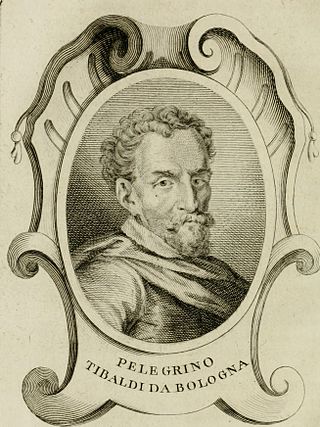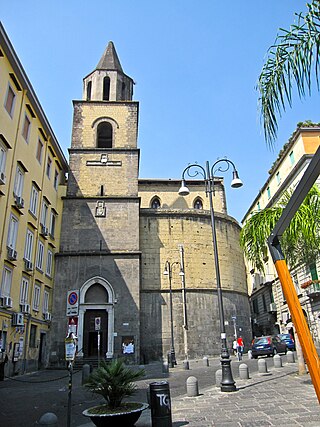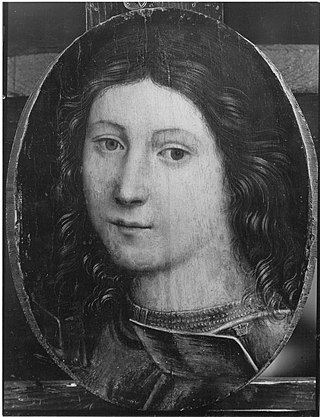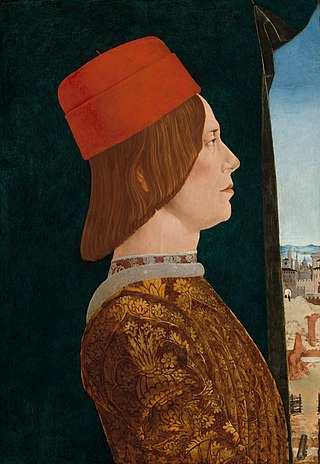
Pellegrino Tibaldi, also known as Pellegrino di Tibaldo de Pellegrini, was an Italian mannerist architect, sculptor, and mural painter.

The Bentivoglio family was an Italian noble family that became the de facto rulers of Bologna and responsible for giving the city its political autonomy during the Renaissance, although their rule did not survive a century.

Amico Aspertini, also called Amerigo Aspertini, was an Italian Renaissance painter and sculptor whose complex, eccentric, and eclectic style anticipates Mannerism. He is considered one of the leading exponents of the Bolognese School of painting.

The Basilica of San Petronio is a minor basilica and church of the Archdiocese of Bologna located in Bologna, Emilia Romagna, northern Italy. It dominates Piazza Maggiore. The basilica is dedicated to the patron saint of the city, Saint Petronius, who was the Bishop of Bologna in the fifth century. Construction began in 1390 and its main facade has remained unfinished since. The building was transferred from the city to the diocese in 1929; the basilica was finally consecrated in 1954. It has been the seat of the relics of Bologna's patron saint only since 2000; until then, they were preserved in the Santo Stefano church.

San Pietro a Majella is a church in Naples, Italy. The term may also refer to the adjacent Naples music conservatory, which occupies the premises of the monastery that used to form a single complex with the church.

Sant'Onofrio al Gianicolo is a titular church in Trastevere, Rome. It is the official church of the papal order of knighthood Order of the Holy Sepulchre. A side chapel is dedicated to the Order and a former grand master, Nicola Canali is entombed there. It is located on the Janiculum. Since 1946, the church has been under the care of the American congregation of the Franciscan Friars of the Atonement.

Orazio Samacchini was an Italian painter of the late-Renaissance and Mannerist style, active in Rome, Parma, and his native city.

Ercole Grandi was an Italian painter of the early-Renaissance period, active mainly in Ferrara. Also known as Ercole da Ferrara and Ercole di Giulio Cesare Grandi, he has been claimed to be a favourite pupil of the painter Lorenzo Costa. Ercole Grandi first appeared in the historical record as being in the service of the house of Este in 1489. Between 1489 and 1495, Ercole Grandi seems to have been working in Bologna, both in San Petronio and in the Cappella Bentivoglio of San Giacomo Maggiore, as an assistant to Lorenzo Costa. In 1495, he was in Ferrara as the chief architect for realising Duke Ercole's plans to embellish the city and renovate the churches; the facade and interior of Santa Maria in Vado were executed from his design. He worked with Ludovico Mazzolino and others on the decoration of the Castello, and painted in the apartments of Lucretia Borgia. Also in Ferrara, he painted the frescoes for the church of San Pietro Martire, although some frescoes are preserved. One problem in assigning attribution to the hand of Ercole Grandi is that none of his works is signed or dated, or accompanied by supporting documents, but he is thought by some scholars to have painted—in the manner of Mantegna—or had a hand in, the decorative frescoed ceiling in the Sala del Tesoro of the Palazzo Costabili in Ferrara between 1503 and 1506. Other scholars attribute the work to Benvenuto Tisi da Garofalo. Confusingly, the identity of Ercole Grandi is sometimes conflated with Garofalo, and an Ercole da Bologna, and with that of Ercole di Antonio Roberti or Ercole de' Roberti, who was first documented as being in Ferrara in 1479, and was author of the great frescoes of the Garganelli chapel in Bologna. Most of Ercole Grandi's works have been reattributed to other Ferrarese painters, such as Giovan Francesco Maineri and Lorenzo Costa, while other scholars insist that Ercole Grandi is a mythical character.

San Maurizio al Monastero Maggiore is a church in Milan, Northern Italy. It was originally attached to the most important female convent of the Benedictines in the city, Monastero Maggiore, which is now in use as the Civic Archaeological Museum. The church today is used every Sunday from October to June to celebrate in the Byzantine Rite, in Greek according to the Italo-Albanian tradition. It is also used as a concert hall.

Giovanni II Bentivoglio was an Italian nobleman who ruled as tyrant of Bologna from 1463 until 1506. He had no formal position, but held power as the city's "first citizen." The Bentivoglio family ruled over Bologna from 1443, and repeatedly attempted to consolidate their hold of the Signoria of the city.

The Bentivoglio Altarpiece is a painting by the Italian Renaissance painter Lorenzo Costa, dating to August 1488. It is displayed in the Bentivoglio Chapel of the church of San Giacomo Maggiore, Bologna, Italy.

San Martino church, also called San Martino Maggiore is a Gothic-style, Roman Catholic church located at the corner of Via Marsala and Via Guglielmo Oberdan in Bologna, region of Emilia Romagna, Italy. The church was founded by the adjacent Carmelite monastery. On 10 August 1704 via the authority of the Vatican Chapter, the venerated image of the Virgin of Mount Carmel was crowned by Pope Clement XI. On 25 August 1941, Pope Pius XII elevated it to the status of basilica.

Giovanni Poggio was an Italian Roman Catholic bishop and cardinal. He is mainly known for the elaborate decorations he arranged for his residence, the Palazzo Poggi.

The Palazzo Poggi is a palazzo in Via Zamboni 33, Bologna, Italy. It is the headquarters of the University of Bologna and of the rector of the university.
Bartolomeo Triachini or Bartolomeo Tassi (1516–1587) was a Bolognese architect.

San Giovanni in Monte is a 15th-century Roman Catholic church in Bologna, Italy.

The Oratory of Saints Cecilia and Valeriano is a religious site in central Bologna, found on Via Zamboni, contiguous to the portico of the church of San Giacomo Maggiore.

Palazzo Malvezzi Campeggi is a Renaissance palace located on Via Zamboni number 22, at the corner (southwest) with Via Marsala, in central Bologna, region of Emilia Romagna, Italy. It stands across from San Giacomo Maggiore, and just northeast of the Palazzo Magnani. It presently houses the law faculty of the University of Bologna.
San Girolamo is a 15th-century Roman Catholic church located in Spello, province of Perugia, region of Umbria, Italy.
The Palazzo Vizzani Lambertini Sanguinetti, sometimes known merely as Palazzo Vizzani, is a Renaissance palace located on Via Santo Stefano #43 in the center of Bologna, region of Emilia-Romagna, Italy. Presently the palace houses the faculty of Foreign Languages and Literature of the University of Bologna.



















